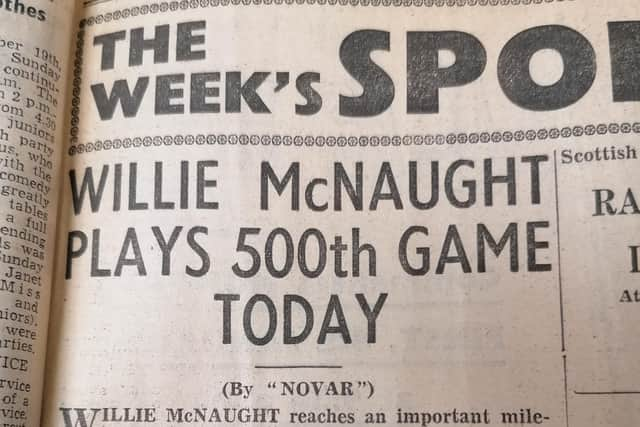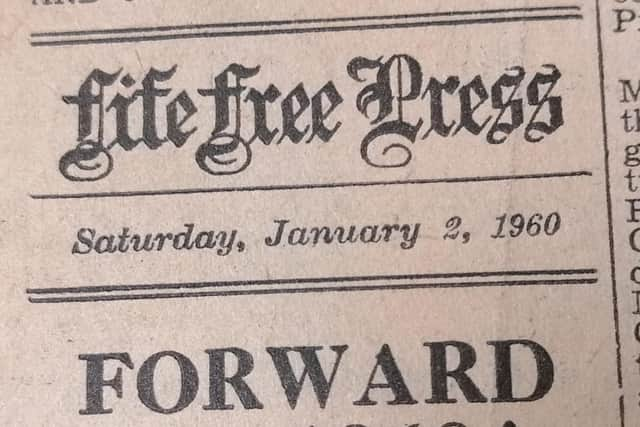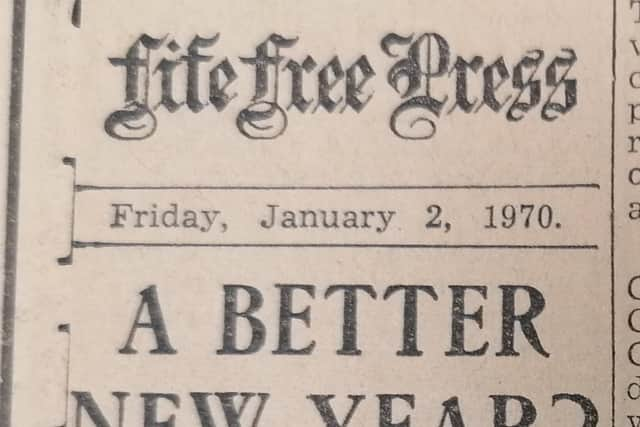New decade dawns: How Kirkcaldy ushered in 1960, 1970 and 1990
and live on Freeview channel 276
It is also a great opportunity to look back and see how town has entered similar landmarks.
From the 1950s to the 1990s and into the Millennium, the issues may have changed but that hope of a better tomorrow still rings true.
Advertisement
Hide AdAdvertisement
Hide Ad

Previous generations endured the horrors of war and marveled at the rapid rise in technology which took man to the moon and back again.
But local issues prevailed too - from the traditional to the mundane, while some seem to come round on a loop.
In 1990 plans for a major redevelopment of the Esplanade were unveiled … and here we are, 30 years on, watching the diggers move in to create another new look!
Advertisement
Hide AdAdvertisement
Hide AdThe Swinging Sixties started quietly, if the front pages of the Fife Free Press are anything to go by.


The editorial comment noted: “Few people will be sorry to see the 1950s go” and noted “a series of crises which seemed to tumble into our laps one after the other” recalling Suez affair, a credit squeeze, the temporary return of petrol rationing, the Cold war, and the H-Bomb.
The Press stated: “The 60s will not be easy but with courage, determination, initiative and foresight, we can march foward into 1960 with a fair degree of confidence that our standard of living can be further improved if if we care to exert ourselves.”
The biggest story at the start of the year, however, came on the sports pages.
Advertisement
Hide AdAdvertisement
Hide AdRaith Rovers’ legend, Willie McNaught, played his 500th game for the club.


And how did the 60s shape up?
The Press seemed a tad underwhelmed.
Its 1970 editorial reflected on “the decade of disappointment - a place of controversy and confusion as man’s scientific achievements vied with his bestiality for a place in the world’s headlines.”
In Kirkcaldy it was “a year of consolidation rather than spectacular, if any, marked progress.”


The Press noted the re-opening of Burntisland Shipyard , the continued recovery of the linoleum industry and the long awaited start to the town’s swimming pool - but there were also strikes by busmen, dustmen and teachers to contend with.
You may also be interested in:
Advertisement
Hide AdAdvertisement
Hide AdThe closure of Sinclairtown and Dysart railways had caused inconvenience, while a rise in tolls on the Forth Road Bridge saw another burden on commuters.
Conditions hadn’t hit the ‘red alert status’ which prevailed across some Scottish counties, but the bug was taking its toll.
Half of the staff at Carlton Restaurant were off, while morning service at Victoria Road Church was conducted by three elders after minister, the Rev Mungo Carrick, was laid low.
In smaller Post Offices throughout the county, the situation was so bad that deliveries were being made only when it was possible rather than to any timetable.
Advertisement
Hide AdAdvertisement
Hide AdRaith Rovers dressing room was hit with a number of players confined to quarters, while staff and fiscals at the Sheriff Clerk’s office suffered for over one week.
An urgent appeal was made to people to return empty medicine bottles to chemist shops to combat a national shortage.
Kirkcaldy’s mighty industrial strength was evident as the Press reported on plans to increase workforces, with women gaining most of the jobs.
Kirkcaldy’s Department of Employment and Productivity said there was so much work for women that their register of unemployment was right down to elderly women.
Advertisement
Hide AdAdvertisement
Hide AdForbo Nairmn had a workforce of 2400 and was looking to expand on the back of growing demand for cushioned vinyl products.
GEc-AEL were about to become major producers of new telephone equipment which meant a substantial increase in its workforce
Its factories at Mitcheston and in Glenrothes employed 1000 people each - the forecast was for 500 more
Babygrow’s 500-strong workforce was expected to rise to 500 people while linen manufacturer N. Lockhart & Sons, Links St needed 20 per cent more staff to keep up with demand.
Advertisement
Hide AdAdvertisement
Hide AdMelville Plastics Machinery, anticipated 10-12 new personnel, with director,David Bertram declaring: “We project continuous growth through the whole decade.”
There was talk of 30 new jobs with AH McIntosh, ten at Barnet & Morton structural engineers, while Scotblair Pelts, Kinghorn - which undertook final preparations of sheepskins before they were dispatched for manufacture into leather goods - anticipated 40 new posts.
That optimism con tinued into 1971 with business on the upsurge. Councillors were confident that the Michelin Tyre Company would move into Chapel Industrial Estate, with a further 400 jobs at, GEC-AEI .
Rank Strand’s focus on Kirkcaldy saw more jobs in the pipeline, and Nelbarden swimwear was also looking for staff.
Advertisement
Hide AdAdvertisement
Hide AdIn the collieries, Frances had assurances for the next 20 years while Seafield produced more coal, and faster, than any other colliery in Scotland - it enjoyed a record breaking 1970.
By 1990, coal was just about still king, but the future was less certain.
The Press’ editorial noted new hope for the Kingdom’s traditional industry with a £100m redevelopment of Frances and the promise of 1000 new jobs now two years old.
“What is needed is a sorely needed New Year’s resolution from British Coal to confirm it is going ahead,” it stated.
Advertisement
Hide AdAdvertisement
Hide AdAs that industry began its slow decline to zero, 1990 also saw the wraps come off a multi million £ project to revive the Wemyss villages.
The Press revealed a £20m plan that could create 300 permanent jobs, and include an 18 hole golf course, tourism and leisure facilities, and refurbished housing. unveiled by Wemyss Estate and Wemyss Development Company, it was billed as “a new gateway to the East Neuk.”
And, 30 years ago, the Press also reported on a major development of the town’s waterfront … exactly as we did again in 2019!
£4m facelift for “the town’s “decaying Esplanade” took in Pathhead and also up St Clair Street.
Advertisement
Hide AdAdvertisement
Hide AdSweeping changes were planned to revitalise the area and create new opportunities for Kirkcaldy as it entered a new decade.
It envisaged repacing the entire Prom, landscaping works along the entire esplanade, construction of a new tourism office and a recreayion area at Pathhead Sands. Dysart Harbour got almost £200,000 for repairs and improvements, and there was £1m for a facelift for the Rosslyn St./St Clair St area - all part of a four-year masterplan.
David Rae, planning director said: “We have the chance to give a lead to others by converting a serious problem into a major opportunity.
“There is no doubt there is a need to carry out a series of significant improvements to remove the stigma of neglect and decay which pervades the whole area.”
As we begin another decade, the same waterfront is undergoing its latest facelift.
Wonder what it will look like in 2050 …